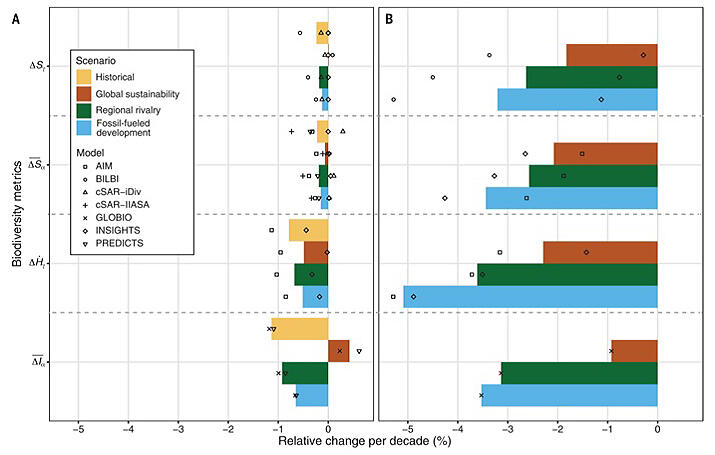An international research group, which includes Professor Tomoko Hasegawa of the Research Organization of Science and Technology at Ritsumeikan University, along with the Forestry and Forest Products Research Institute, Kyoto University, and the National Institute for Environmental Studies, has announced the characterization of biodiversity and ecosystem service trends over a 150-year period from 1900 to 2050. This was achieved through an intermodal comparison study that utilized multiple simulation models and biodiversity indicators. Biodiversity declined globally by 2%−11% during the 20th century. Regarding ecosystem services during the same period, the study found that regulating services such as pollination and nutrient retention decreased while provisioning services such as food and timber from the ecosystem increased by several times. If measures are implemented, the decline in regulating services will be slowed, but if not, the negative impacts will continue at the same rates as in the past, revealing the need for further action. The results were published in the international academic journal Science on April 26.

Provided by Ritsumeikan University
The 20th century saw unprecedented rates of biodiversity loss, to which the increase in the human population and economic growth are considered to have made the most notable contribution. Previous scenario studies on climate change and biodiversity have used simulation models to examine future socioeconomic development pathways and their impacts. Meanwhile, studies using a single model had issues, such as only one aspect of biodiversity could be evaluated.
In response to this, the research group reorganized and reconstructed historical data on biodiversity, climate change, and land use from 1900 to 2015 and combined them with the results of future simulations from 2015 to 2050 to conduct a model intercomparison analysis of biodiversity and ecosystem services. Three future scenarios were assumed, combining socioeconomic conditions such as population, economic development, and land-use change with the climate policy implementation status and the climate change level. To examine the contribution of land-use change and climate change as two major factors acting on biodiversity, they compared the assessments of the three scenarios with the assumption of land-use change alone and the assumption of land-use change plus climate change.
The scenarios were as follows:
- (1) "Global sustainability scenario" with climate change and land use under control (corresponding to a climate change level with an average temperature increase of 2℃).
- (2) "Regional rivalry scenario" assuming moderate-level climate change and high-level land-use change.
- (3) "Fossil-fueled development scenario" assuming high-level climate change and moderate-level land-use change.
The biodiversity indicators were calculated for a multidimensional assessment of biodiversity and ecosystem services, combining eight models for biodiversity and five models for ecosystem services. The result showed that biodiversity decreased by 2%−11% over 100 years of the 20th century. Scenario (1) forecasted a slower rate of future biodiversity loss than in the 20th century, while biodiversity loss was predicted to continue at the same rate as in the 20th century under scenarios (2) and (3). This was strongly tied to climate change, as the rate of biodiversity loss increased when climate change effects were considered.
Regarding ecosystem services, the 20th century saw an increase in provisioning ecosystem services (such as food and timber) and a decrease in regulating services (such as pollination and nutrient retention) globally, and this trend was predicted to continue for the next several decades. Scenario (1) showed that measures toward sustainable development, such as transition to slower population growth and healthier diets, increasing the crop productivity of the land, and implementing additional environmental protection policies, would reduce biodiversity loss and improve ecosystem services. On the other hand, scenarios (2) and (3) showed that adverse impacts on biodiversity and ecosystem services would continue at the same rate as in the past.
Hasegawa said, "When you hear about protecting biodiversity, you may wonder what you can do about it. However, I want the public to know that sustainable efforts also contribute to its conservation. For example, you can review what you eat to reduce food loss and make choices that will reduce greenhouse gas emissions. I hope the study provides an opportunity for everybody to rethink how they live their lives."
Journal Information
Publication: Science
Title: Global trends and scenarios for terrestrial biodiversity and ecosystem services from 1900 to 2050
DOI: 10.1126/science.adn3441
This article has been translated by JST with permission from The Science News Ltd. (https://sci-news.co.jp/). Unauthorized reproduction of the article and photographs is prohibited.




